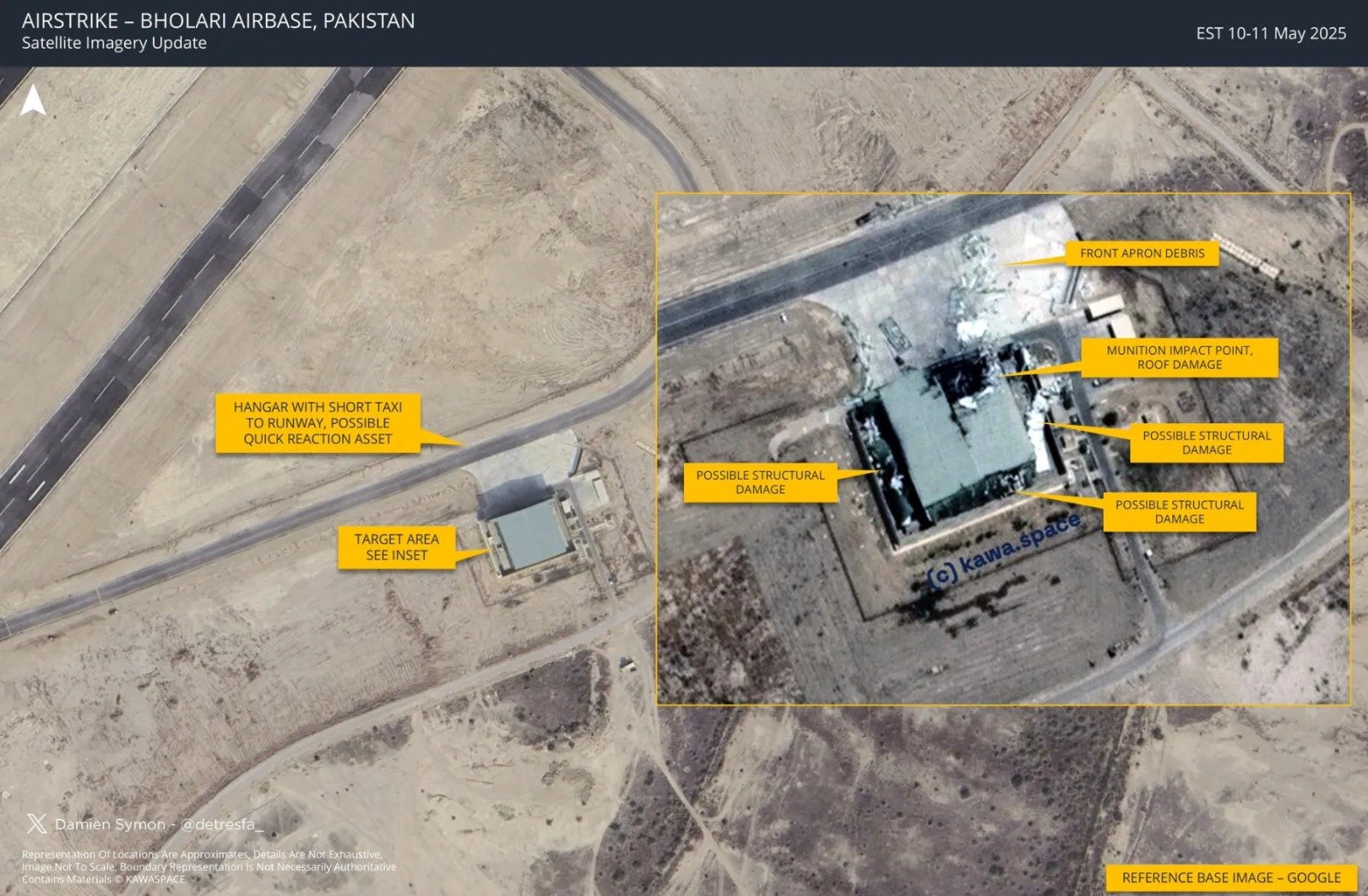In a bold and coordinated military operation, the Indian Air Force (IAF) has struck several key airbases across Pakistan, as part of its retaliatory response to the April 22 terrorist attack in Pahalgam, Jammu and Kashmir, which killed 26 civilians.
The strikes, launched under Operation Sindoor, aimed to degrade Pakistan’s offensive air and drone capabilities by targeting core infrastructure. Satellite imagery from Indian and international sources confirms extensive damage to high-value assets across the affected sites.
At Bholari Airbase near Hyderabad in Sindh, satellite images from Indian firm KawaSpace on May 10 show a heavily damaged hangar close to the runway, likely used for quick-reaction operations. Reports indicate that a SAAB 2000 Erieye AWACS aircraft undergoing maintenance inside the hangar was destroyed. Casualty estimates suggest the loss of Squadron Leader Usman Yousaf and over 40 personnel, alongside four damaged drones, marking a significant hit to Pakistan’s surveillance and response capabilities.
Nur Khan Airbase in Rawalpindi, a strategic transport hub for the Pakistan Air Force, was also targeted. Satellite imagery from Chinese firm MizarVision shows damage to fuel trucks and training facilities near the apron, although key aircraft such as the C-130 Hercules and IL-78 refuelers appear unaffected. The precision of the strike suggests a calculated intent to disrupt logistics rather than provoke full-scale escalation.
In southern Pakistan, Jacobabad Airbase—known for drone launch operations—was reportedly hit by missile strikes targeting UAV maintenance and command infrastructure. Indian officials have linked this strike to recent Pakistani drone activity along India’s western frontier, where 300 to 400 drones, including Turkish-made Songar models, were launched between May 8 and 9. Many of these were intercepted by India’s Barak-8 and S-400 systems.
Sargodha Airbase in Punjab, which hosts squadrons under Pakistan’s Central Air Command, was another key target. Though independent imagery is limited, defense sources suggest damage to runways and aircraft shelters. This would likely impair Pakistan’s ability to quickly deploy fighter aircraft such as the F-16 in response to future threats.
These coordinated strikes were part of a broader Indian campaign following the deadly Pahalgam terror attack, which India blames on Pakistan-based militants affiliated with Lashkar-e-Taiba and the Resistance Front. On May 7, India launched precision strikes on multiple airbases including Chaklala, Rafiqui, Murid, and Rahim Yar Khan. The Indian government emphasized that these actions were “focused and non-escalatory,” designed to dismantle terror-linked military infrastructure while minimizing civilian harm.
Pakistan described the strikes as an act of war, reporting over two dozen civilian deaths and dozens more injured. However, India has maintained that all targets were military in nature and avoided residential areas. Satellite imagery corroborates India’s assertion that the damage was localized and strategic.
A tentative ceasefire was reached through military hotlines on May 10, following days of missile exchanges, drone interceptions, and artillery shelling. Despite the agreement, subsequent explosions were reported over Srinagar and Jammu, suggesting ongoing low-level hostilities.
International reactions have been mixed. The United States, which earlier stated the conflict was a bilateral matter, has since urged India to halt further strikes. Meanwhile, India is preparing to present evidence of Pakistan’s terror links at the UN Security Council next week. China has acknowledged damage at the Nur Khan base through satellite data but has remained diplomatically neutral.
The focus on disabling air assets and drone infrastructure highlights a shift in India’s strategic posture—toward precise, punitive actions against cross-border threats.













